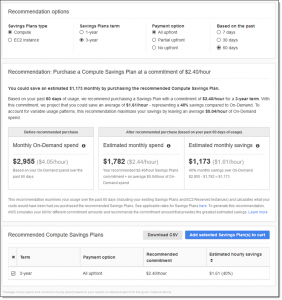Amazon AWS Savings Plans – A new way to pay
Amazon have introduced a new way to pay for Amazon Cloud Services – Savings Plans.

Currently, the main way to save money on your Amazon AWS infrastructure is via Reserved Instances (RIs). These enable you to pre-purchase, for 1 or 3 years, types of Virtual Machines (VMs) at a discounted rate, giving you lower pricing when those specified resources run – but if you don’t use them, you lose them…and the money you spent. Additionally, there are a few different types of RI with different features etc. To paraphrase Uncle Ben: “with great RI adoption comes great management overhead”.
Organisations can spend a lot of time and person-power keeping track of, and optimising, their RI estate. Making sure RIs are purchased for all relevant resources (which can be difficult given how quickly new cloud infrastructure can appear), ensuring the cloud resources are of the correct types to make optimal use of the RIs already purchased, and managing un-used RIs and analysing whether changes can be made to the resources being used etc.
In fact, RI management is a large part of what several IaaS cloud management tools focus on, as being able to automate a big chunk of this work saves a lot of time for cloud analysts, FinOps practitioners, ITAM teams et al.
Amazon Savings Plans
This is a new approach to paying for Amazon AWS resources and aims to remove all the time and hassle associated with managing Reserved Instances. In a nutshell, you commit to an hourly rate for every hour of the 1- or 3-year contract – and that’s that.
Two types of Savings Plans
Compute Savings Plans
These offer similar “up to 66%” discount rates as the current “Convertible RI” and have great flexibility – applying across region, family, OS, tenancy etc. and apply across EC2 and Fargate – Amazon’s service that lets you run containers without managing underlying virtual machines.
EC2 Instance Savings Plan
Applicable only to EC2 and, like a Standard RI, offers discounts of up to 72% on a specific instance family within a region.
Amazon AWS Cost Explorer will provide a recommendation based on your historical usage:

Taken from https://aws.amazon.com/blogs/aws/new-savings-plans-for-aws-compute-services/
In the above example, a $2.40 per hour commitment over 3 years is $63,072 – which, as with RIs, you can choose to pay “All upfront”, “Partial upfront”, or “No upfront”.
The end of cloud cost management for AWS?
Not by a long shot!
Savings Plans should enable you to reduce the amount of time spent managing this part of your Amazon AWS infrastructure – to a certain degree. Cloud cost management is a large, wide reaching area and the benefits of Savings Plans only cover a small part of it – there is still the internal cost management to understand who has spent how much, on what, where, and why etc.
Looking at support pages from Apptio-Cloudability, it seems that the new Savings Plans may in fact make some of these internal elements more difficult, as certain key information isn’t included in the Savings Plans billing file.
You need to be careful before committing to a Savings Plan – make sure that the historical usage on which it is based is realistic. If you’ve recently turn off some services – or if you know there are plans to do so – you could find yourself paying more per hour than you require.
As with almost everything related to ITAM/SAM/software/licensing/cloud, this makes one bit easier, another potentially harder, and there’s still a whole lot left to do. Also, don’t forget the 100s (if not 1000s) of other Amazon AWS services not covered by Savings Plans or RIs!
Further Reading
Amazon AWS announcement – https://aws.amazon.com/blogs/aws/new-savings-plans-for-aws-compute-services/
AWS info page – https://aws.amazon.com/savingsplans/pricing/
Apptio-Cloudability support page – https://support.cloudability.com/hc/en-us/articles/360038190694
Related articles:
Bringing together all aspects of technology asset management: Interview with Piyush Patel, ServiceNow
We don’t talk about ITAM (no, no, no)
Trelica awarded ITAM Review certification for Enterprise SaaS Management
Prioritising your Software Licensing Risks
Adobe Creative Cloud - A Look into the Crystal Ball
Whitepaper: Six stages to building a valuable SAM practice
About Rich Gibbons
A Northerner renowned for his shirts, Rich is a big Hip-Hop head, and loves travel, football in general (specifically MUFC), baseball, Marvel, and reading as many books as possible. Finding ways to combine all of these with ITAM & software licensing is always fun!
Connect with Rich on Twitter or LinkedIn.
